Tooth Discolouration (Stained Teeth): Causes, Prevention and Treatment

What is Tooth Discolouration?
Tooth discoloration occurs when the colour of your teeth changes. This colour change makes your teeth appear less bright or white than usual. In some cases, your teeth might darken, shift from white to other shades, or develop white or dark spots in certain areas.
Types of tooth discoloration
There are several causes of tooth discoloration:
Extrinsic: Caused by external factors that come into contact with your teeth.
Intrinsic: Caused by internal factors within your teeth or body.
Genetics: Caused by your genetics.
Age-related: Occurs naturally as you age.
Disease-related: Caused by chronic health conditions or medications that you take.
Causes of Tooth Discolouration
Tooth discoloration can result from multiple and a combination of factors such as the following:
Foods and Drinks
Coffee, tea, colas, wines, and certain fruits and vegetables (like apples and potatoes) can stain teeth.
Tobacco Use
Smoking, vaping or chewing tobacco often leads to tooth staining.
Poor Dental Hygiene
Inadequate brushing, flossing, and rinsing can fail to remove plaque and substances that cause stains.
Disease
Certain diseases affecting enamel (the hard outer layer) and dentin (the underlying layer) can cause tooth discoloration. Treatments like radiation and chemotherapy for specific conditions can also change tooth colour. Infections during pregnancy may affect enamel development, leading to discoloration in babies.
Medications
Antibiotics such as tetracycline and doxycycline can discolour teeth in children under eight years old. Mouth rinses and washes containing chlorhexidine and cetylpyridinium chloride, as well as antihistamines (e.g., Benadryl), antipsychotic drugs, and medications for high blood pressure, can also cause tooth discoloration.
Dental Materials
Some dental materials, like amalgam restorations, especially those containing silver sulphide, can give teeth a grey-black hue.
Aging
Over time, the enamel on your teeth wears down, revealing the natural colour of the underlying dentin.
Genetics
Some individuals naturally have brighter or thicker enamel than others.
Environment
Excessive fluoride from environmental sources (like water with high fluoride levels) or overuse of fluoride products (applications, rinses, toothpaste, and supplements) can lead to tooth discoloration.
Trauma
Injuries, such as a fall, can disrupt enamel formation in young children whose teeth are still developing, or cause discoloration in adult teeth.
What do the different colours of tooth discolouration mean?
The way your teeth change colour can provide clues about the underlying cause:
Yellow tooth discolouration
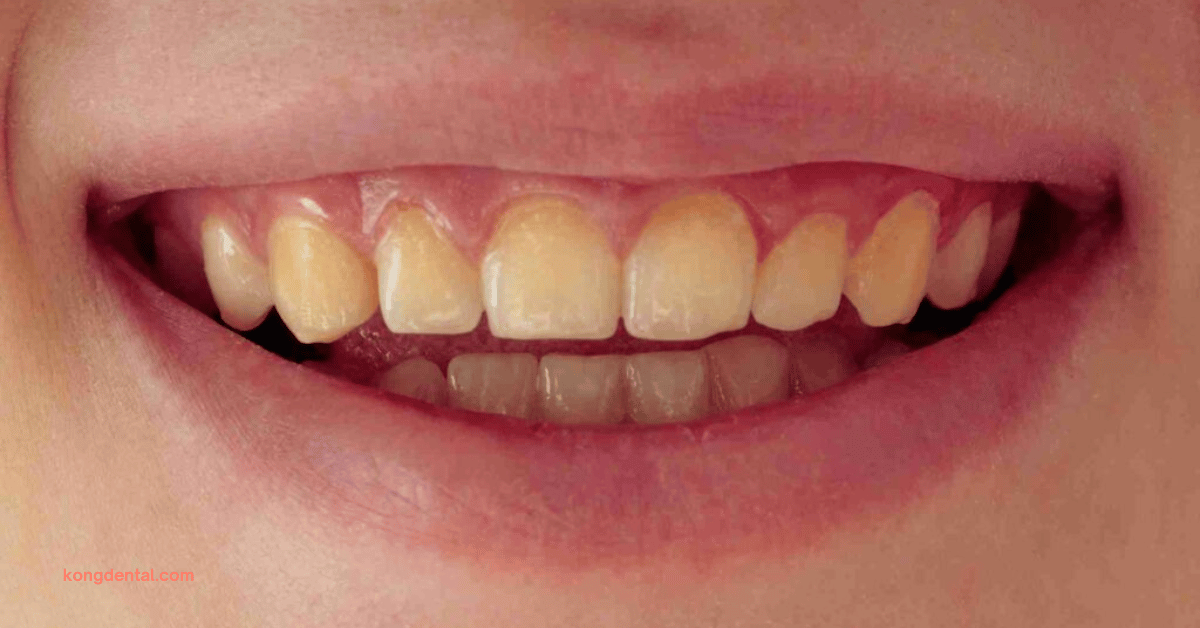
As you age, the white enamel on your teeth may wear down, revealing the yellowish layer beneath.
Brown tooth discolouration
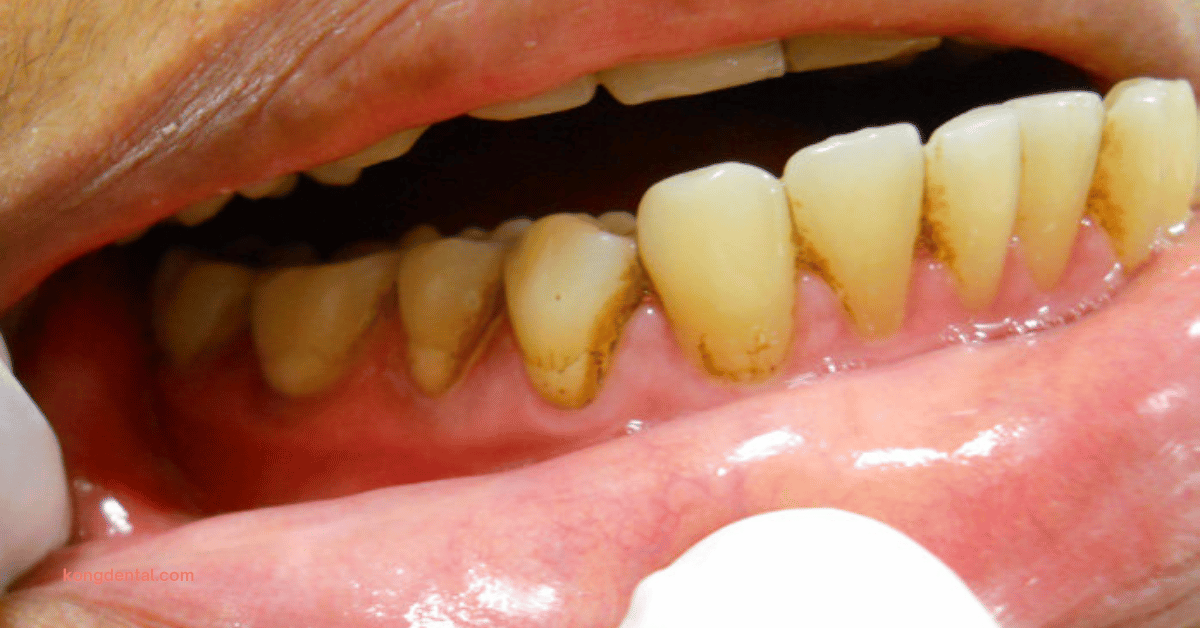
Brown discoloration can result from tobacco use, dark beverages like coffee or tea, or poor oral hygiene that leads to tooth decay.
White tooth discolouration
Excessive fluoride exposure during tooth development can cause white spots, a condition known as fluorosis. This occurs when teeth are exposed to too much fluoride from drinking water, rinses, or toothpaste.
Black tooth discolouration
Tooth decay or pulp necrosis may cause teeth to turn greyish or black. Chewing betel nuts or exposure to certain minerals like iron, manganese, or silver (either in industrial settings or through supplements) can also result in black discoloration or lines.
Purple tooth discolouration
Drinking red wine can stain your tooth enamel, leaving a purple tint.
Care and Treatment of Tooth Discolouration
How do dentists treat discoloured teeth?
Dentists treat discoloured teeth using various methods, depending on the underlying cause and the extent of the discoloration. One common approach is professional teeth whitening, where a dentist applies a bleaching agent to the teeth. This can be done in the office with stronger whitening agents or through custom-made trays for at-home use with milder solutions. Whitening treatments are particularly effective for surface stains caused by food, drink, or smoking.
For more severe discoloration, such as stains that are intrinsic or related to medication use, dentists may recommend veneers or bonding. Veneers are thin shells made of porcelain or composite resin that are placed over the front of the teeth to improve their appearance. Bonding involves applying a tooth-coloured resin to the teeth and then hardening it with a special light. Both options are effective at covering up deep stains that cannot be addressed with whitening alone.
In cases where discoloration is due to decay or damage, the dentist will first treat the underlying issue. This might involve removing decay and filling cavities, performing a root canal treatment if the pulp is affected, or addressing other dental health problems. Once the teeth are healthy, the dentist may then proceed with cosmetic treatments to improve their color.
For patients with discoloration caused by fluoride or other environmental factors, the treatment might include microabrasion, a procedure that gently removes a thin layer of enamel to reduce the appearance of stains. In some cases, a combination of treatments may be used to achieve the best results.
Dentists will also provide guidance on how to prevent future discoloration, including advice on diet, oral hygiene, and the use of fluoride products.
Teeth whitening
Teeth whitening involves the use of bleaching agents to lighten the colour of teeth. This can be done in-office by a dentist or at home using over-the-counter products.
- In-office whitening: A dentist applies a high-concentration bleaching agent to your teeth and uses a special light to activate it. This can achieve dramatic results in a single session.
- At-home whitening: Over-the-counter options include whitening strips, gels, and toothpaste. These products typically contain a lower concentration of bleaching agent and require multiple applications over time.
How it helps: Teeth whitening is effective for treating surface stains caused by factors like coffee, tea, red wine, and smoking. It can significantly brighten the appearance of teeth.
Dental bonding
Dental bonding is a cosmetic procedure that involves applying a composite resin material to a tooth and shaping it to improve its appearance.
- Process: A dentist prepares the tooth by roughening the surface. The composite resin is then applied in layers, shaped, and cured with a special light.
- Applications: Bonding can be used to repair chips, cracks, or gaps in teeth, as well as to mask discoloration.
How it helps: While bonding can help to mask discoloration, it is not as effective as whitening for treating deep-seated stains. It is a good option for minor cosmetic issues.
Porcelain veneers
Porcelain veneers are thin, custom-made shells that are bonded to the front of teeth to improve their appearance.
- Process: A dentist prepares the teeth by removing a thin layer of enamel. The veneers are then fabricated in a dental laboratory and bonded to the prepared teeth.
- Applications: Veneers can be used to correct a variety of cosmetic issues, including discoloration, chips, cracks, gaps, and misshapen teeth.
How it helps: Porcelain veneers are a highly effective way to mask severe discoloration and create a beautiful smile. They are durable, stain-resistant, and can last for many years.
Dental crowns
Dental crowns are full-coverage caps that are placed over damaged or discoloured teeth to restore their function and appearance.
- Process: A dentist prepares the tooth by removing a portion of its enamel. A crown is then fabricated in a dental laboratory and cemented onto the prepared tooth.
- Applications: Crowns are often used to treat severely discoloured teeth, as well as those that are cracked, chipped, or weakened.
How it helps: Dental crowns can effectively mask severe discoloration and restore the tooth’s strength and function. They are a durable and long-lasting treatment option.
Can I fix a discoloured tooth?
Yes, you can fix a discoloured tooth, and there are several treatment options available depending on the cause of the discoloration and your specific needs. If the discoloration is superficial, such as stains from food, drinks, or smoking, professional teeth whitening treatments can be highly effective. These treatments, offered by dentists, use bleaching agents to lighten the teeth and remove surface stains.
For more stubborn or intrinsic stains, treatments like dental veneers or bonding might be recommended. Veneers are custom-made shells that cover the front of the teeth, providing a new, whiter surface. Bonding, on the other hand, involves applying a tooth-coloured resin to the tooth, which is then shaped and polished to match the surrounding teeth.
In cases where the discoloration is due to an underlying dental issue, such as decay or trauma, it’s important to first address the root cause. This may involve treatments like fillings, crowns, or root canals. Once the tooth is healthy, cosmetic procedures can then be used to improve its appearance.
Your dentist can assess the cause of your tooth discoloration and recommend the most appropriate treatment to restore your tooth’s natural colour.
How can I fix discoloured teeth at home?
Fixing discoloured teeth at home is possible for mild stains and discoloration, though it may not be as effective as professional treatments. Here are some methods you can try:
Whitening Toothpaste
Use a toothpaste specifically designed to remove surface stains. These toothpastes contain mild abrasives or special chemicals that help polish the teeth and lift stains. They can gradually whiten your teeth over time with regular use.
Over-the-Counter Whitening Kits
These kits typically include whitening strips, gels, or trays that contain a lower concentration of bleaching agents compared to professional treatments. Follow the instructions carefully to apply the product to your teeth for the recommended duration. These kits can help brighten your smile, though the results may vary.
Baking Soda
Brushing with baking soda a few times a week can help remove surface stains. Baking soda is mildly abrasive and can gently scrub away discoloration. However, it should be used sparingly to avoid damaging the enamel.
Oil Pulling
Swishing a tablespoon of coconut oil in your mouth for 15-20 minutes daily is an old practice believed to help reduce plaque and remove stains. While not scientifically proven to whiten teeth dramatically, some people find it beneficial for improving overall oral health.
Dietary Changes
Avoid foods and drinks that stain teeth, such as coffee, tea, red wine, and berries. Drinking through a straw and rinsing your mouth with water after consuming these can minimize staining. Eating crunchy fruits and vegetables like apples and carrots can also help clean teeth naturally.
Maintaining Good Oral Hygiene
Regular brushing, flossing, and rinsing with an antiseptic mouthwash can help prevent new stains from forming and keep your teeth looking brighter.
While these methods can help improve the appearance of discoloured teeth, they may not be as effective for deeper or more severe discoloration.
How to prevent tooth discolouration?
Preventing tooth discoloration involves a combination of good oral hygiene practices, dietary choices, and lifestyle habits. Here’s how you can keep your teeth looking bright:
Practise Good Oral Hygiene
Brush your teeth at least twice a day with fluoride toothpaste and floss daily to remove plaque and prevent stains. Regularly using an antiseptic mouthwash can also help reduce bacteria that cause discoloration.
Be Mindful of Your Diet
Limit your consumption of foods and drinks known to stain teeth, such as coffee, tea, red wine, berries, and tomato-based sauces. If you do consume these, try to rinse your mouth with water afterward to minimise staining.
Use a Straw
When drinking beverages that can stain teeth, like sodas, juices, or wine, use a straw to reduce direct contact with your teeth.
Quit Smoking and Tobacco Use
Tobacco products, including cigarettes and chewing tobacco, are major contributors to tooth discoloration. Quitting these habits can help maintain the whiteness of your teeth.
Stay Hydrated
Drinking plenty of water throughout the day helps wash away food particles and bacteria that can cause stains. It also helps maintain saliva production, which naturally protects against tooth discoloration.
Regular Dental Check-ups and Cleanings
Visit your dentist regularly for professional cleanings and check-ups. Professional cleanings can remove surface stains that at-home brushing might miss, keeping your teeth brighter.
Use Whitening Products Cautiously
Overuse of whitening products, including toothpaste, strips, and rinses, can sometimes cause tooth sensitivity or damage the enamel. Follow the instructions carefully and consult your dentist before using them regularly.
Get Fluoride in Moderation
While fluoride is beneficial for preventing cavities, excessive fluoride exposure can lead to a condition called fluorosis, which causes white spots on the teeth. Ensure you’re not overusing fluoride supplements or toothpaste.
By incorporating these practices into your routine, you can significantly reduce the risk of tooth discoloration and keep your smile bright.
When Should I Call the Dentist for Tooth Discolouration?
Tooth discoloration can be a concern, but it is not always a dental emergency.
However, there are instances when you should consult a dentist promptly:
Pain or Sensitivity: If your discoloured tooth is accompanied by pain, sensitivity to hot or cold temperatures, or swelling, it could indicate a more serious dental issue, such as an infection or nerve damage.
Sudden or Significant Discoloration: If you notice a sudden or significant change in your tooth’s colour, especially if it is accompanied by other symptoms, it’s best to seek professional advice.
Discoloration After Trauma: If your tooth discoloration occurred following an injury, it is important to have it checked by a dentist to ensure that there is no underlying damage.
Discoloration in Children: If you notice discoloration in a child’s teeth, it is advisable to consult a dentist to rule out potential causes like dental fluorosis or other developmental issues.
Cosmetic Concerns: If you are concerned about the appearance of your discoloured teeth and want to explore treatment options such as teeth whitening or veneers, a dentist can provide guidance and recommendations.
While many cases of tooth discoloration are cosmetic, it is always best to consult a dentist for a proper evaluation to address any underlying dental issues and discuss appropriate treatment options.
Kong Dental Surgery – Professional Teeth Whitening Near You
If you are living near Jurong, Teck Whye, Sunshine Place (Choa Chu Kang), Limbang, or Yew Tee and are looking for teeth whitening treatment, Kong Dental Surgery might be suitable for your teeth whitening treatment needs.
Book an appointment with us to see whether you are suitable for teeth whitening treatment.
Tooth Discolouration: Frequently Asked Questions
Why is only one tooth discoloured?
There are several reasons why only one tooth might be discoloured:
Injury or Trauma: A single tooth may become discoloured due to a past injury or trauma, such as a blow to the face or a chipped tooth.
Dental Infection: An infection within a tooth, often caused by untreated decay, can lead to discoloration.
Internal Bleeding: Internal bleeding within the tooth can cause it to darken.
Medications: Certain medications can cause tooth discoloration as a side effect.
Dental Fluorosis: If a child consumes too much fluoride during tooth development, it can lead to dental fluorosis, which can cause white spots or discoloration on the teeth.
Age and Wear: Over time, teeth can naturally become discoloured due to age, wear, and staining from food and beverages.
Is there such a thing as temporary tooth discolouration?
Yes there is such a thing as temporary tooth discolouration. This often occurs due to external factors, such as:
Food and Beverages: Certain foods and drinks, like coffee, tea, red wine, and dark-coloured berries, can stain teeth temporarily.
Tobacco: Smoking or chewing tobacco can cause temporary discoloration.
Certain Medications: Some medications can temporarily affect tooth colour.
Temporary Staining Agents: Products like mouthwashes or whitening treatments can sometimes cause temporary staining.
These stains are usually superficial and can often be removed or reduced with proper oral hygiene practices, professional cleaning, or over-the-counter whitening products. However, if the discoloration persists or is accompanied by other symptoms, it is advisable to consult a dentist to rule out any underlying dental issues.
Can I save a blackened tooth?
Whether or not you can save a blackened tooth depends on the underlying cause of the discoloration. If the discoloration is due to external factors like staining, it may be possible to restore the tooth's appearance through professional cleaning, whitening treatments, or veneers.
However, if the discoloration is caused by internal issues such as infection, nerve damage, or trauma, more extensive treatment may be necessary. In some cases, a root canal treatment or even extraction may be required to save the tooth or prevent further damage.
Do consult a dentist for a proper evaluation to determine the best course of action. They can assess the severity of the discoloration and recommend appropriate treatment options.
Can a dead discoloured tooth be whitened?
No, a dead, discoloured tooth cannot be whitened. When a tooth becomes dead, the nerve and pulp within it have been lost. The discoloration is often caused by the breakdown of organic material within the tooth, which is irreversible.
However, there are cosmetic options available to improve the appearance of a discoloured dead tooth. These may include:
- Dental crowns: A crown can be placed over the discoloured tooth to mask the discoloration and restore its shape and function.
- Dental veneers: Veneers are thin, custom-made shells that can be bonded to the front of the tooth to improve its appearance.
What is the best dental treatment for tooth discolouration?
The best dental treatment for tooth discoloration depends on the underlying cause and the desired outcome.
If the discoloration is caused by external factors like staining, professional cleaning, over-the-counter whitening products, or in-office whitening treatments can often be effective.
However, if the discoloration is due to internal issues such as dental trauma, infection, or medication, more extensive treatments may be necessary.
Here are some common dental treatments for tooth discoloration:
Professional cleaning: Regular dental cleanings can help remove surface stains and improve the appearance of teeth.
Over-the-counter whitening products: These products, such as whitening toothpaste, mouthwash, or strips, can help lighten surface stains.
In-office whitening treatments: Professional in-office whitening treatments can achieve more dramatic results in a shorter period.
Dental veneers: Veneers are thin, custom-made shells that can be bonded to the front of teeth to mask discoloration and improve their appearance.
Dental crowns: Crowns can be used to cover severely discoloured or damaged teeth.
Root canal therapy: In cases where discoloration is caused by an infection, root canal therapy may be necessary to treat the infection and prevent further damage.
Make An Enquiry
Let us know your concerns and our clinic staff will get back to you in 1-2 hours.
Prefer to talk to our clinic staff directly? Call our clinic to chat with our friendly nurses at +65 6767 9502
General Information
-
Yew Tee Point
21 Choa Chu Kang North 6 #01-27 Singapore 689578
Tel: +65 6767 9502
(Please Enter The Clinic From Outside The Mall) -
Consulting Hours
Mon to Fri: 9AM to 9PM
Sat: 9AM to 6PM
Sun and PH: Closed
Related Articles
-
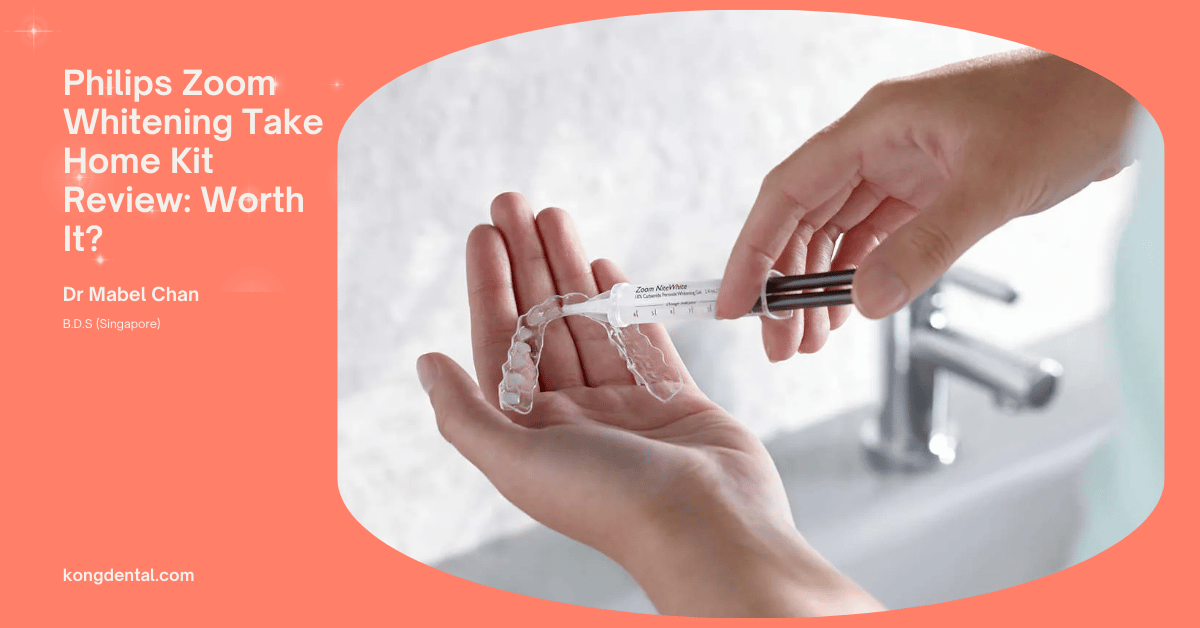
Philips Zoom Whitening Take Home Kit Review: Worth It?
As a dentist with over a decade of experience working with different teeth whitening treatments, I have written this review to help you decide whether...
Read More -
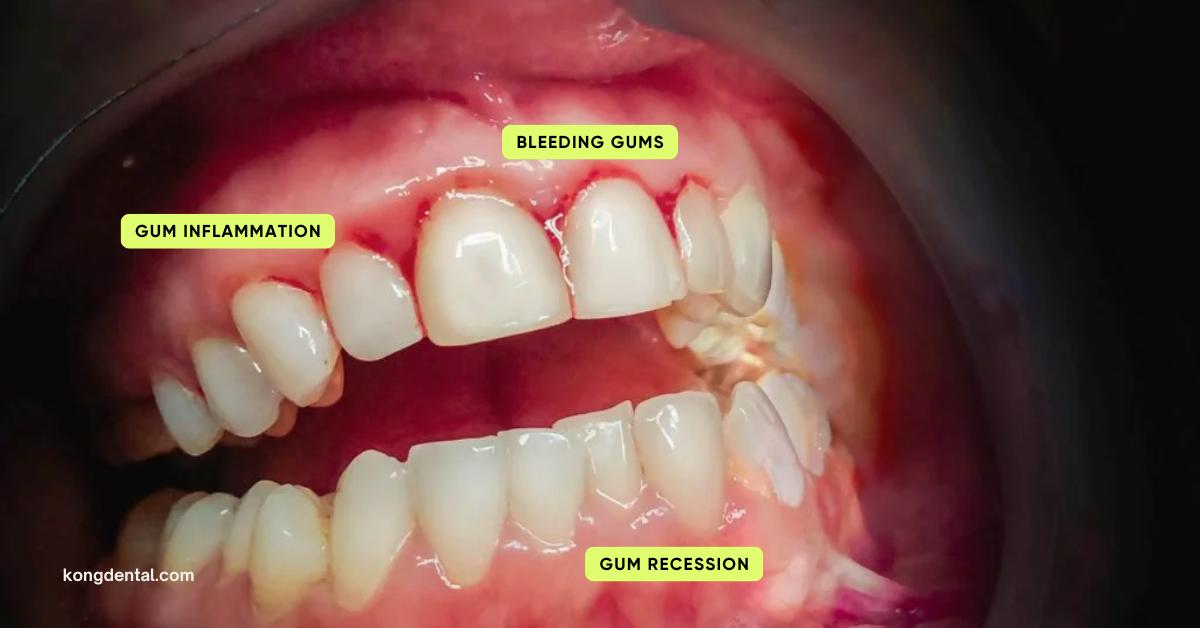
Smile Bright, Live Right: 5 Ways How Gum Disease Affects Your Health
Your smile does more than light up a room. It reflects the state of your overall health. While most of us are familiar with the...
Read More -
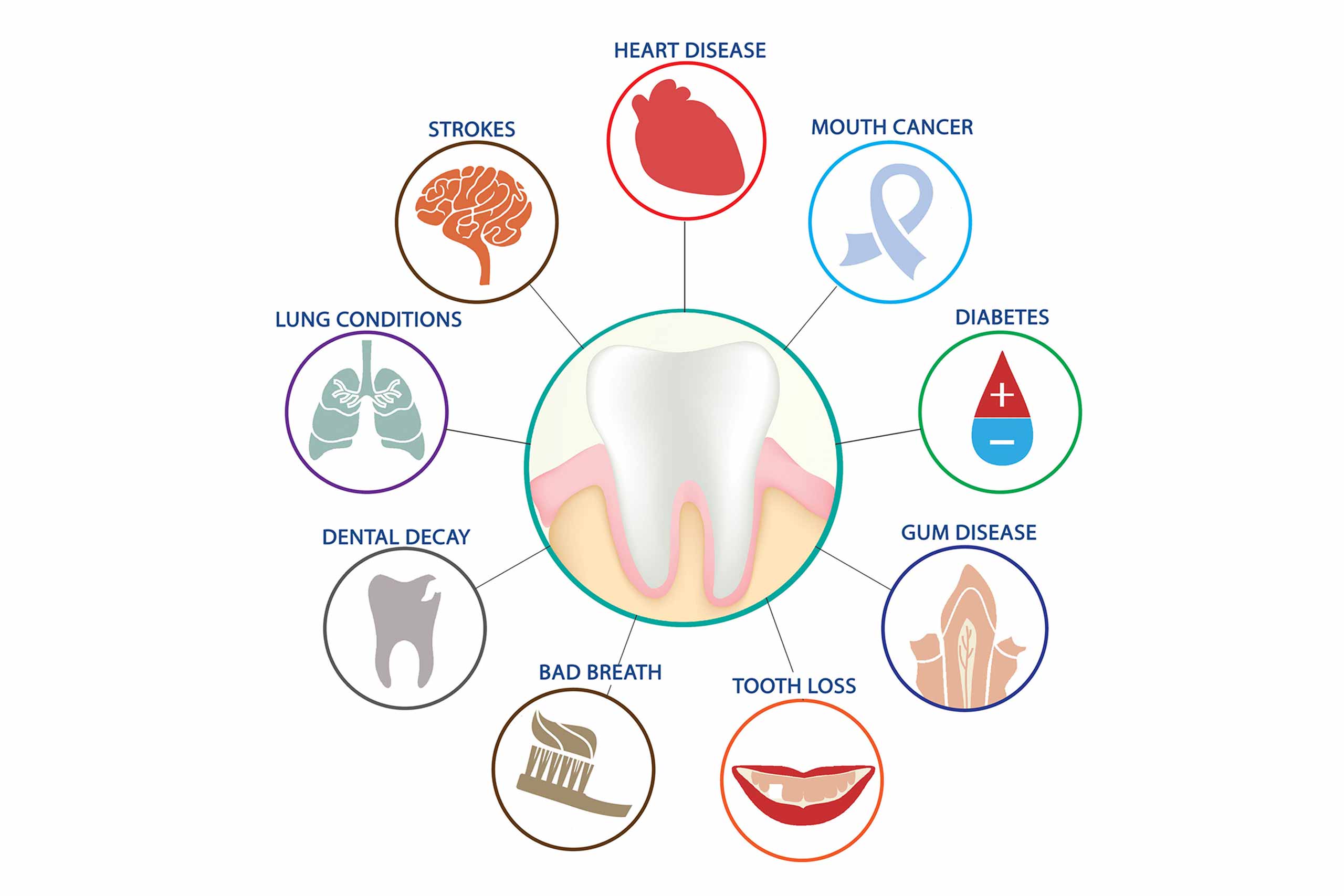
The Surprising Connections Between Oral Health & Well Being
Maintaining good dental health extend far beyond just your mouth. There is a growing body of research that suggests a synergic relationship between oral health...
Read More -
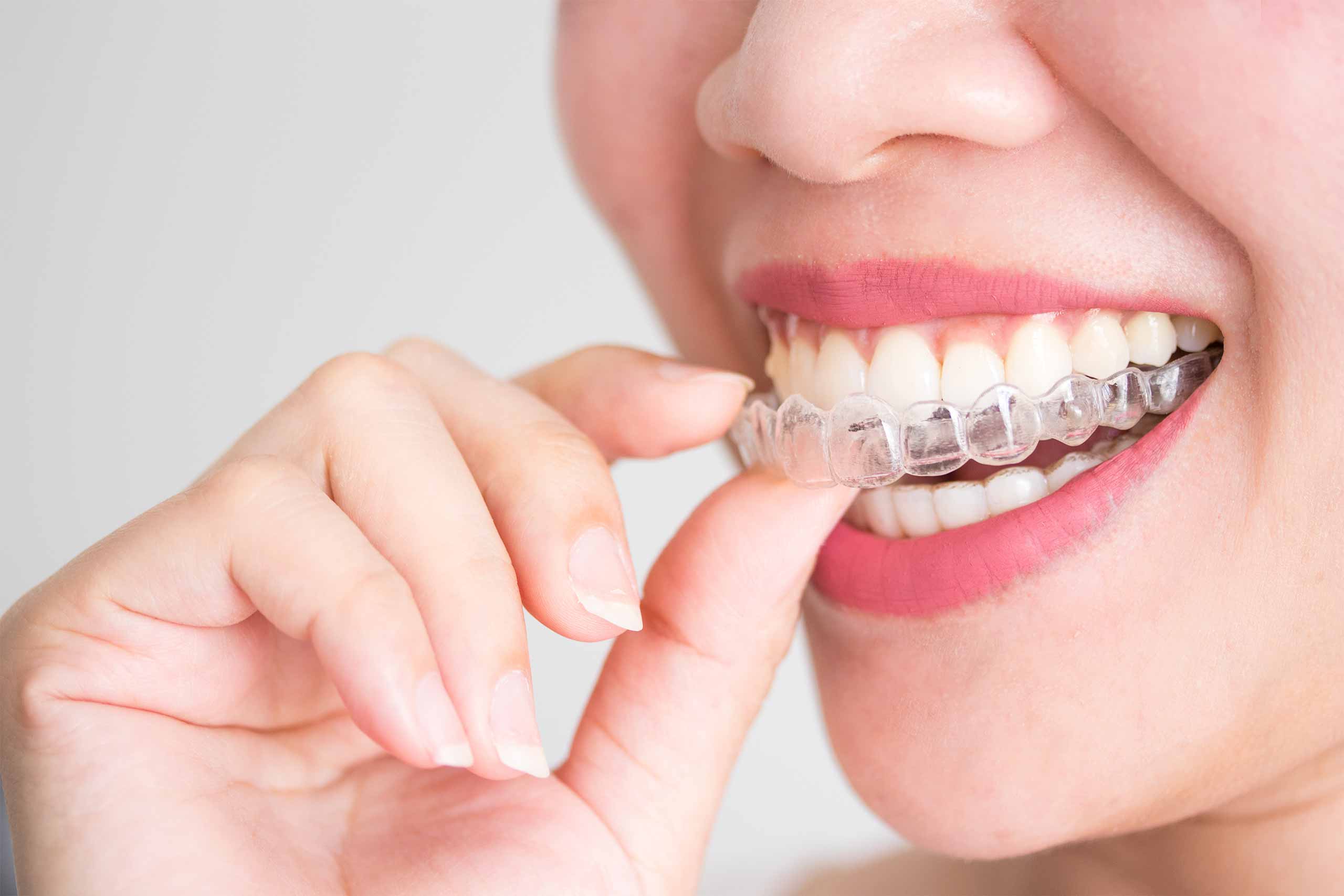
What You Need to Know About Invisalign
Are you or your child looking to straighten teeth with Invisalign? I have written a quick guide for you to help you understand Invisalign better...
Read More -
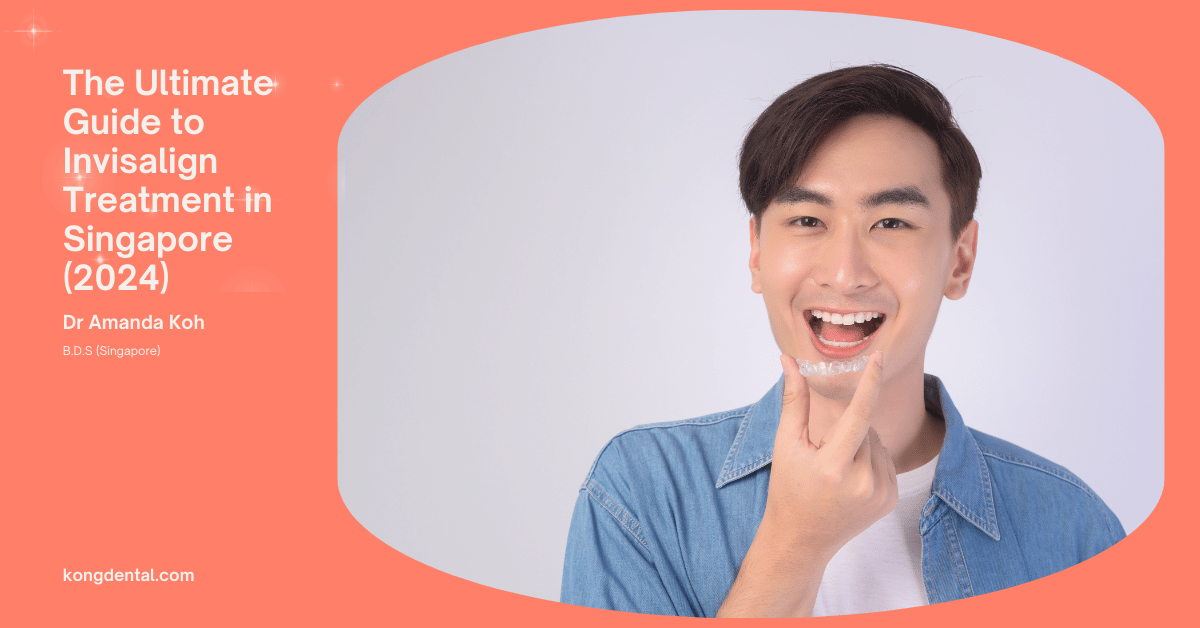
The Ultimate Guide to Invisalign Treatment in Singapore (2024)
If you have been considering teeth straightening treatment with Invisalign or are seeking a discreet, convenient and effective way to sort out your crooked teeth,...
Read More


